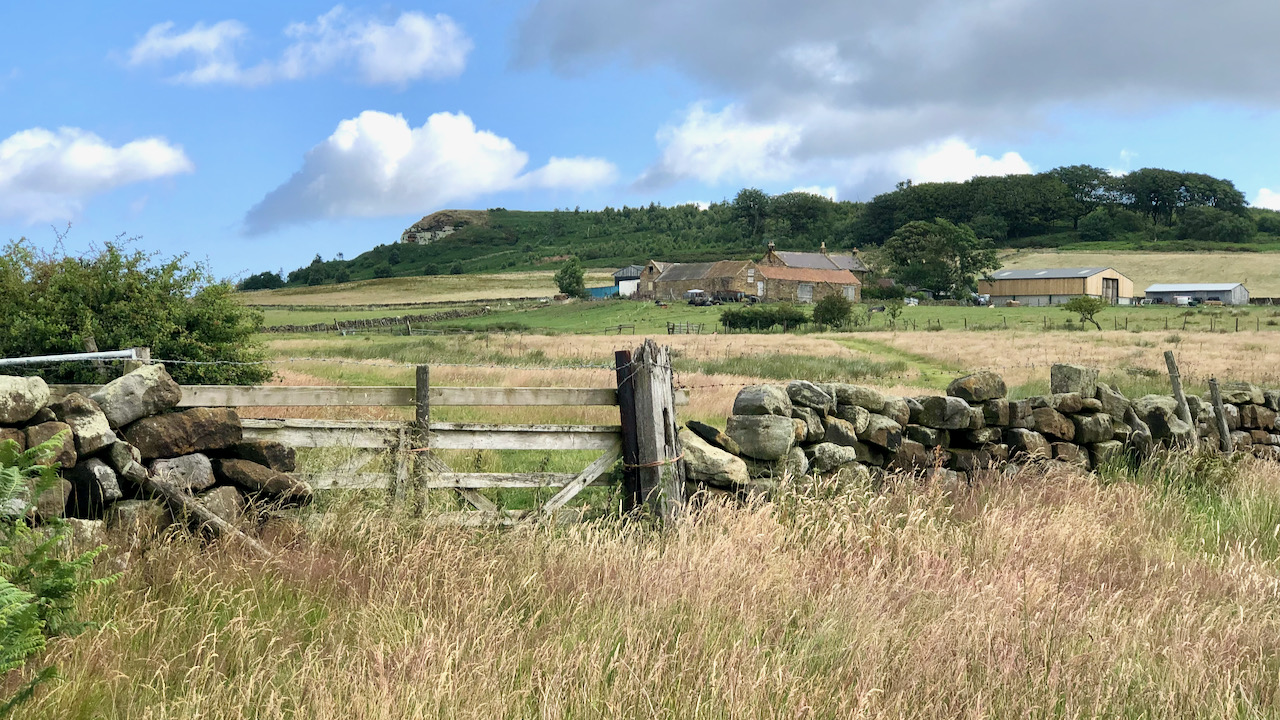I’ve posted about Highcliffe Farm before, located on the wide and shallow col between Highcliff Nab and Great Ayton Moor; unsheltered from the winds from the north and the south. One might question the wisdom of setting up a farm in such an exposed spot.
The landscape owes its origins to the ancient forces of nature; the col emerging as a spillway cascading southwards from the lakes that developed between the north-facing escarpment of the Cleveland Hills and the glacier that followed the course that would later become the Tees valley1Ypsyork.org. (2021). Percy Fry Kendall | Yorkshire Philosophical Society. [online] Available at: https://www.ypsyork.org/resources/yorkshire-scientists-and-innovators/kendall/#:~:text=A%20lot%20of,to%20Lake%20Eskdale [Accessed 7 Dec. 2021]..
While the farmhouse and one of the outhouses boast a heritage dating back to the early 18th century2North York Moors National Park. (2012). HER Map: North York Moors National Park. HER No: 16553. [online] Available at: https://www.northyorkmoors.org.uk/discover/archaeology/her-map [Accessed 7 Dec. 2021]., there have been suggestions of a potential connection to the farm in a 1602 survey. Back then, Codhill Farm formed part of the Chaloner estate. However, in 1806, Robert Chaloner sold it to his agent, Joseph Hickson. Subsequently, Hickson resold to a certain Ralph Potter, who, it is presumed, lent his name to Potter’s Ridge, the northern terminus of which happens to be none other than Highcliff Nab. By 1820, the farm had passed through three more hands, leaving us to ponder the doubts surrounding its viability.
Around this period, the dry-stone wall across Codhill Slack—as seen in the photograph—was built, and the region southwest of the farm was “improved”. This parcel of land had hitherto been known as ‘Peat Carr Hill,’ but it became ‘Bold Venture,’ perhaps as a tribute to the audacity of this ambitious endeavour. Alas, by the close of the century, these fields had regressed into a wild and unkempt state, prompting a subsequent attempt at improvement. The name ‘Bold Venture,’ however, perseveres in Bold Venture Gill, whose upper reaches bisect the enclosed fields of the farm.
The mid-19th century witnessed several further changes in ownership, eventually culminating in the acquisition of Codhill Farm by Henry Thomas in 1851. It didn’t take long for Thomas to lease both the farm and its valuable mining rights to the enterprising Joseph Whitwell Pease. Undoubtedly, Pease possessed an astute foresight, recognising the immense potential hidden below those fields.
When Thomas died in 1866, Pease was redirecting his focus from ironstone mining at Codhill to his thriving mine at Upleatham. Consequently, the rent that Thomas’ widow received from Codhill Farm dwindled. Ever the shrewd businessman, Pease offered to purchase the farm outright from her in 1869. Initially met with resistance, three years later, the widow accepted his proposal.
Today, on the large scale O.S. maps, Codhill Farm is called Highcliffe Farm, which must be the ‘official’ name by virtue of its entry into the Post Office’s esteemed database of addresses.
Further Reading
Dixon, Grace. “Two Ancient Townships – Studies of Pinchinthorpe and Hutton Lowcross”. ISBN 0 9507827 2 6 1991.
- 1Ypsyork.org. (2021). Percy Fry Kendall | Yorkshire Philosophical Society. [online] Available at: https://www.ypsyork.org/resources/yorkshire-scientists-and-innovators/kendall/#:~:text=A%20lot%20of,to%20Lake%20Eskdale [Accessed 7 Dec. 2021].
- 2North York Moors National Park. (2012). HER Map: North York Moors National Park. HER No: 16553. [online] Available at: https://www.northyorkmoors.org.uk/discover/archaeology/her-map [Accessed 7 Dec. 2021].

Leave a Reply